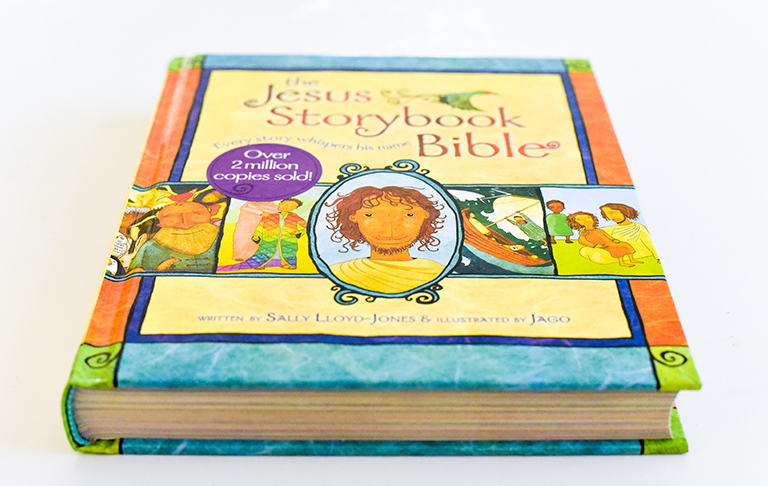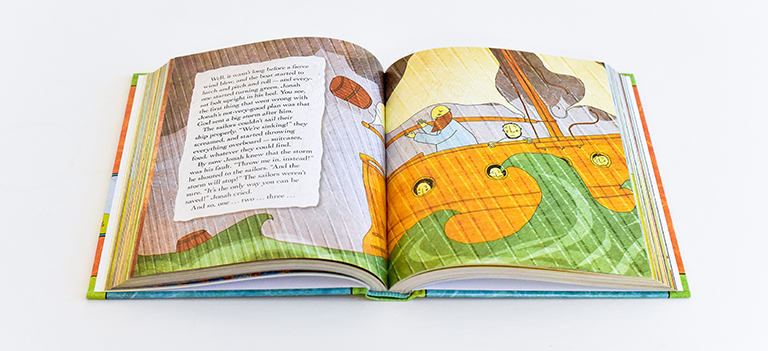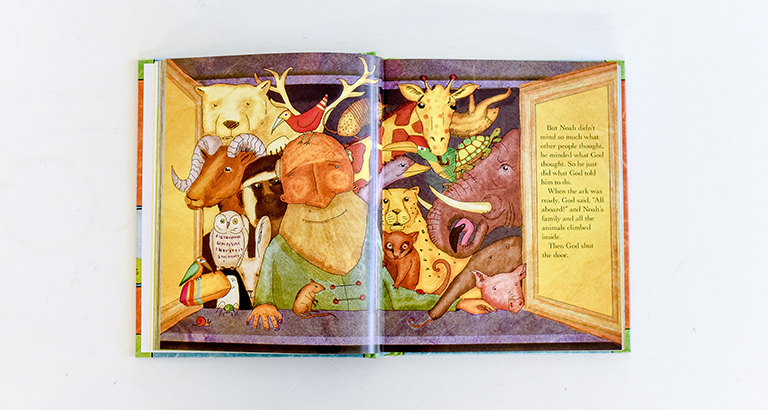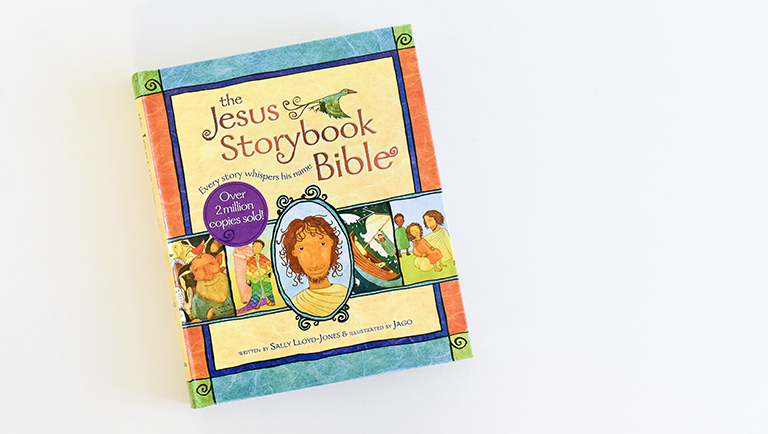The Jesus Storybook Bible is one of so many children’s Bibles. It’s easy to feel overwhelmed by the variety and unsure which is best for your bookshelf. So, here at ICM, we’ve compiled our thoughts in this blog series where we’ll be reviewing some of today’s most popular children’s Bibles. Once you find your fave children’s Bible, check out our post on ways of reading scripture with your kids to get the most out of it!
 Quick Facts about The Jesus Storybook Bible
Quick Facts about The Jesus Storybook Bible
- 352 Pages
- Author: Sally Lloyd-Jones, Illustrator: Jago
- Storybook format (a retelling of some of the Bible)
- Age Range: 4-8 years old
- Bestseller on Amazon
- The Moonbeam Award Gold Medal Winner
A Closer Look
There’s no perfect choice for all children everywhere or even for your own child. Each children’s Bible is a mix of aspects to love as well as those that invite palm to forehead moments. In this series of reviews, we’ll always include what we think to be the pros and cons of each Bible and whether or not we’d recommend it to our friends. So, let’s dive in and take a closer look at The Jesus Storybook Bible.
Pros of The Jesus Storybook Bible
Engaging Illustrations: Award-winning illustrator Jago produces dynamic, vibrant illustrations. They’re beautifully expressive, engaging, and simple in presentation.
Digestible Story Length: The stories, which are retold compilations of several chapters, are short. This aspect makes it easy to hold the attention of young readers.
Table of Contents Included: Having a table of contents makes for easy reading, especially if a child has favorites they like to return to repeatedly.
Classic Stories Included: All the classic stories you’d hope for from a children’s Bible are included here.
Name Plate Included: The first page contains a nameplate for gifting it to a child. A parent, children’s director, teacher, or family member would appreciate this.
Compact Size: This children’s Bible is medium-sized (6.6 x 1 x 7.9 inches). It is small enough to stow in a child’s backpack for church or travel.
Appropriately Illustrated Characters: Figures are shown with olive skin and dark hair, honoring the Bible’s Middle Eastern context.
Biblical Passages Cited: Each retelling of a biblical story gives the biblical passages from which the author drew. This increases biblical literacy and makes for easy cross-referencing.
Cons of The Jesus Storybook Bible
Unfamiliar Story Titles: While the story titles are creative and fun, they aren’t the names we normally associate with biblical stories. This can make it difficult to find a particular story. Additionally, a child may struggle to make the connection between stories as they age and begin reading out of a complete Bible.
Imposed Narrative: In The Jesus Storybook Bible, the thread that holds all the stories together is Jesus. This for some is the biggest selling point. However, this was not the intention of the biblical authors. Furthermore, imposing the narrative of Jesus’ life and mission onto the Hebrew scriptures can present problems. To mention just one, such theology can easily lead to anti-Semitic thinking. That is, one can argue that Jews don’t know how to interpret their own holy texts and are “missing the point.”
Exclusively Masculine Language for God: God is neither male nor female but possesses a nature far more complex and integrated. If we are to use one gender to metaphorically describe God then we must use all genders. If not, using non-gendered language for God is ideal. This is standard practice in most seminaries; there is no reason it shouldn’t be common practice in the pulpit and faith education of young ones.
Inaccurate Biblical Account: Lloyd-Jones takes much creative license in her retelling. Consequently, there are inaccuracies in the biblical stories. For example, the story of Adam and Eve names the serpent Satan, a fallen angel. Satan asks Eve, “Does God really love you?” To begin, the biblical text doesn’t name the serpent Satan. Furthermore, the serpent doesn’t ask that question of Eve. Moreover, it’s debatable, non-biblical mythology that assumes the character of Satan is a fallen angel. Throughout The Jesus Storybook Bible, several of these unsound portrayals exist.
Conclusion
Children’s Bibles are all different, each with good qualities. And The Jesus Storybook Bible has some things going for it. The illustrations are beautiful and portray the characters appropriately. Its stories are short, and it includes all the classics. It contains a table of contents, scripture references, and a nameplate. And it’s an easy size to take along places.
However, there are several key things that take away from it. First, the story titles are unfamiliar. This can slow learning and make it difficult to find the desired story. Second, Lloyd-Jones weaves the life of Jesus into every story of the Hebrew scriptures. Third, Lloyd-Jones uses gendered language for God that is exclusively male. Fourth and finally, there are several inaccuracies in the stories. When teaching children, we hope to give them an understanding of their faith that invites little undoing and relearning. Enough of life’s events invite that through theological reflection without wild misunderstanding of scripture. In conclusion, in spite of it being a best seller on Amazon and a gold medalist in The Moonbeam Awards, we wouldn’t recommend The Jesus Storybook Bible.
We hope this review has been helpful and has given some food for thought. Share what children’s Bibles you have and love in the comments below!




G says
What child-accessible, engaging Bible story book would you recommend then? Most of the Bibles we have been given are either twee and not engaging, our they are too simple for a preschool child.
Adam Walker Cleaveland says
We have many more to review, and I think you’ll see some good possibilities out there.
Wendy says
Thanks for this. Thoughtfully done.. My friends recommended this Bible, and I quickly stopped using it with my own kids for the very reasons you named.
Erica says
My own children and I love the Jesus Story Book Bible. The illustrations are amazing.
We have several Bibles at home and this is the one they grab more often than not. While I agree that your list of short comings is not insignificant, I feel that it does not deserves the “do not recommend” label.
I am not afraid of being a critical reader of scripture, and teach my children to do the same. They know it is a story book and not the same as the “Big Bible.” I honestly cannot imagine a child or adult confusing this book with a properly translated Bible. They know that we interpret scripture differently than Jews (and other religions), and are taught to respect, admire and learn from those differences. This book isn’t a translation of Hebrew scriptures, it is a story book for a Christian audience and I deeply appreciate the framing of the OT stories as pointing to Jesus. And, while we are very aware of God’s gender being a human construct, the limitations of English language pronouns won’t stop us from enjoying this book, as what it is, a story book and additional resource for raising thoughtful, faithful adults.
James says
On a Masculine tense for The Lord God, there are numerous scriptures; one in Jesus own words, John 6:43-46:
43 Jesus therefore answered and said to them, “Do not murmur among yourselves. 44 No one can come to Me unless the Father who sent Me draws him; and I will raise him up at the last day. 45 It is written in the prophets, ‘And they shall all be taught by God.’ Therefore everyone who has heard and learned from the Father comes to Me. 46 Not that anyone has seen the Father, except He who is from God; He has seen the Father.
On Satan’s fallen angel state, might want to read Rev. 12:7-9 again.
7 And war broke out in heaven: Michael and his angels fought with the dragon; and the dragon and his angels fought, 8 but they did not prevail, nor was a place found for them in heaven any longer. 9 So the great dragon was cast out, that serpent of old, called the Devil and Satan, who deceives the whole world; he was cast to the earth, and his angels were cast out with him.